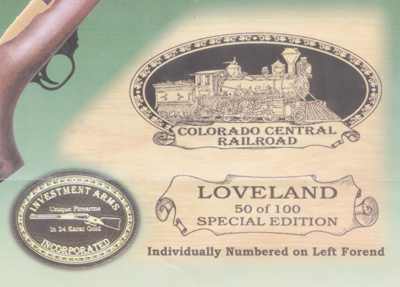Brief by Central Staff
Colorado Central – June 2004 – Colorado Central Magazine
Ray Schoch, a subscriber and contributor in Loveland (along the Front Range about 50 miles north of Denver), sent us a promotional flier for a “Colorado Central” commemorative rifle, connected to Loveland and the Colorado Central Railroad.
There are some connections to Colorado Central Magazine, although they’re more philosophic than geographic or historic.
In the 1860s and ’70s, during territorial and early statehood days, Colorado had two main political factions: the “Denver Crowd” and the “Golden Crowd.”
The Denver Crowd, led by John Evans and David Moffat, promoted their city, and to that end built railroads (Denver Pacific to Cheyenne; Denver, South Park & Pacific;, Denver & New Orleans to Texas) that would make Denver the regional hub.
The Golden Crowd, led by Henry M. Teller, might be more accurately called the “Anywhere but Denver” crowd, since they came from all over the state, but they did try to make a hub of Golden, and their railroad venture was the Colorado Central.
It had a narrow-gauge branch up Clear Creek from Golden. One fork went west to Georgetown and Silver Plume. The other fork went northwest to Black Hawk and Central City, and these days, there’s a “Colorado Central Casino” over there.

The Colorado Central’s standard-gage line angled east from Golden, then north to Boulder, Longmont, Loveland, Fort Collins, and a connection with the Union Pacific at Cheyenne. The idea was to bypass Denver, as much as possible.
One of its main movers was William A.H. Loveland, who left his name on the modern city, as well as on the pass that his rails approached from Georgetown.
The Colorado Central soon fell under control of the Union Pacific, which merged it with another railroad it had acquired, the Denver, South Park & Pacific. When the UP went into receivership after the Panic of 1893, these and other lines were separately organized as the Colorado & Southern, which was eventually swallowed by the Burlington Northern and merged into the modern Burlington Northern Santa Fe.
At any rate, the Colorado Central railroad of the day never got anywhere near the center of Colorado, which is a few miles south of Wilkerson Pass on U.S. 24.
But it was an attempt to build something outside of Denver, and so is this magazine. When we were planning the publication in 1993, we thought a railroad name might be apropos, since railroads once connected and defined regions, just as we hoped to do. Further, Ed’s a railroad buff.
Among Colorado’s scores of defunct railways, two names seemed obvious contenders: Colorado Central and Colorado Midland.
The standard-gauge Midland, built in 1887, ran west from Colorado Springs to Buena Vista, Leadville, and Aspen. The name fit well enough — we are in the midland of Colorado — but the name is tied closely with Colorado Springs (i.e., Midland Expressway), and that’s not where we are.
So we went with Colorado Central. The railroad began operations in 1870 and was merged out of existence in 1881, eleven years later. This magazine turned ten in March, so it has a chance of outliving its namesake railroad. We doubt, however, that the magazine will inspire any commemorative rifles.

